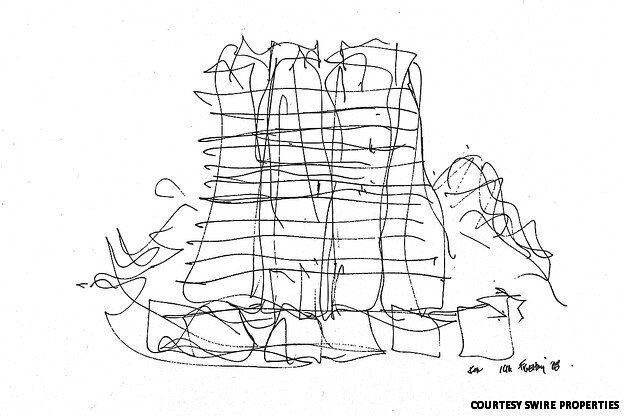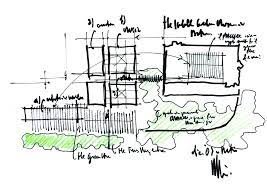From Concept to Canvas: How Artists Inspire Architectural Innovation
Embark on a journey where art and architecture, both distinguished art forms, intertwine in an inspiring dance of creativity. Explore the profound impact of artists on architectural design, showcasing the incredible artists who wield pens and brushes as well as those who craft structures with imagination and flair.
Unlocking Imagination:
In the captivating world where art and architecture engage in a harmonious dance, architects emerge not merely as technical virtuosos but as visionary artists. Let's delve into the imaginative process, exploring how the sparks of creativity from the art world give birth to groundbreaking architectural concepts, seamlessly blending the realms of canvas and construction.
The sketches below were done by artists. This abstract art and abstract thinking is a must to achieve creative and beautiful spaces. Architecture and Interior Design is an artistic AND technical profession. Some of us are more artistic, some more technical.
Forms in Harmony:
In the realm of architecture and interior design, professionals strategically employ forms to establish a harmonious balance, influencing not only the cohesion of our structures but also the ambiance within our interior spaces. This intentional use of like forms serves a dual purpose: it shapes the unity of our buildings and contributes to the rhythm and pattern within our interiors. Architects and interior designers utilize these forms as practical tools, guiding occupants through spaces with effective wayfinding while also unlocking the sensory experience of a given environment. This approach goes beyond aesthetics, demonstrating a thoughtful and functional application of forms to enhance both the structural integrity and experiential aspects of designed spaces.
Color as a Language:
In the realm of art and architecture, color extends beyond mere visual aesthetics, operating as a language that communicates meaning and emotion. Architects, drawing inspiration from the world of artists, employ color as a powerful tool to evoke specific emotions within a space. Within these designed environments, immerse yourself in a spectrum of feelings carefully curated to resonate with the essence of artistic expression. This intentional use of color becomes a nuanced form of communication, subtly shaping the atmosphere and ambiance of a space, enhancing the overall sensory experience without overtly commanding exploration.
Spatial Narratives:
In architectural and design contexts, observe spaces that incorporate narrative depth, reflecting an intentional approach reminiscent of artistic storytelling. Designs are examined as instances where architects use spatial arrangements as a method to weave narratives, drawing inspiration from the storytelling tradition present in various artistic expressions. This systematic integration of spatial elements underscores the role of architects as effective conveyors of narratives within the domain of design.
Materials as Mediums:
In the realm of design, materials serve as mediums of expression. Architects, influenced by artistic craftsmanship, strategically reimagine materials in construction, directing craftsmanship to infuse a distinct touch on the fabric of architectural innovation. For instance, consider an architect incorporating raw, industrial materials to convey a sense of rugged authenticity or opting for sustainable materials to emphasize an environmentally conscious narrative. These examples underscore how architects use materials not just for structural purposes but as deliberate elements that contribute to the overall spatial narrative and aesthetic impact of a design.
The Future Canvas:
Envision a future where architects and artists collaborate seamlessly, influencing the architectural landscape with meticulous strokes of creativity. In this immersive journey, each spark of inspiration on the canvas contributes to an evolving masterpiece of architectural design. This collaborative approach transforms the built environment into a harmonious blend of art and functionality.
The future landscape might feature structures that transcend conventional boundaries, embodying a fusion of artistic expression and architectural ingenuity. Buildings could boast dynamic facades inspired by abstract paintings, where fluid lines and geometric precision coalesce to create visually captivating exteriors.
Internally, spaces might be designed with a heightened emphasis on experiential aesthetics. The dialogue between artists and architects could manifest in interiors that evoke specific emotions, using color schemes and forms derived from the world of art. These spaces would not only serve practical purposes but also engage occupants on a sensory and emotional level.
Materials and construction methods could reflect a commitment to sustainability and innovation. Architects and artists might collaborate to explore unconventional materials, creating structures that not only stand as functional spaces but also serve as environmental statements.
Ultimately, the future of collaborative design between architects and artists could result in a built environment that transcends the ordinary, offering a visually striking, emotionally resonant, and environmentally conscious landscape for inhabitants and observers alike. 🎨🏗️





Waldron Designs, LLC is passionate about designing spaces rooted in their context and responsive to the natural environment. Are you ready to create sustainable permanence with your home?
GET IN TOUCH!